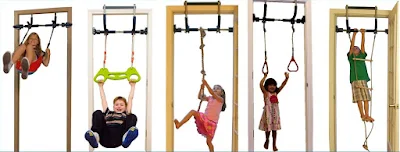However, I realize that some of my sensory hacks aren't always catered to those who live in small spaces such as an apartment. No worries, I've come up with a wonderful list of quick and easy sensory hacks that are just perfect for those of you living in small spaces. Some are really inexpensive and just use materials you have around the home too, which is an awesome way to do occupational therapy at home on a budget.
These ideas are perfect for providing vestibular and proprioceptive sensory input to kids with autism and/or sensory processing disorder, but really these ideas would be great for any child. I've also included some tactile and visual sensory ideas that are perfect for small spaces.
This post contains affiliate links.
Sensory Hacks for Small Spaces
1. Ball pits are great for proprioceptive sensory input, but you don't need a fancy ball pit. Simply add some ball pit balls to a bathtub, laundry basket, or playpen.2. Think you don't have space for a swing? Try this swing kit that hooks up in a door frame, making it a great alternative for those living in small spaces.
3. Crash mats are expensive to buy and even harder to store because they are so bulky. So when your kids are craving some proprioceptive sensory input, you can put together this DIY no sew crash mat in a matter of minutes using items around your house. Simply disassemble when done. No need to store a big fancy crash mat!
4. Pool noodles don't take up a lot of space, but you can use just one pool noodle to make:
- DIY balance board (pictured)
- DIY balance beam (pictured)
- Auditory sensory "telephone" tool
6. You can also turn that underbed storage bin into a DIY light table for some easy visual sensory input. Here's a tutorial for a DIY light box from The Imagination Tree.
7. Our homemade stretchy resistance bands (pictured) take up so little space, but they're great as a chair fidget or for using as a body sock. They're really easy to sew too!
8. Or as an alternative to an actual bin for sensory play, try setting up sensory sinks instead! Here are a few awesome sensory sink ideas to try:
- Pond Themed Sensory Sink from My Nearest and Dearest
- Spelling Sensory Sink from Still Playing School
- Superhero Sensory Sink from Frogs and Snails and Puppy Dog Tail
10. As an alternative to a weighted blanket, which can take up quite a bit of room (they are also expensive!), try these ideas for proprioceptive sensory input:
- Place a large bag of sealed rice on your child's lap
- Weighted lap bag pencil case from Your Kids OT
- DIY weighted stuffed animal tutorial #1 from Joyful Journey Mom (pictured)
- DIY weighted stuffed animal tutorial #2 from Feeding Raya
- DIY weighted animal lap buddies from Simply Blessed Journey of Life (pictured)
- DIY weighted lap bag from Growing Hands on Kids
- DIY weighted lap cushion from Kids Activities Blog




